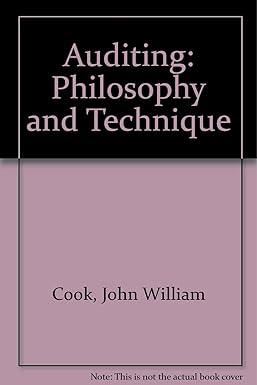Answered step by step
Verified Expert Solution
Question
1 Approved Answer
I need help with these questions please # of Units Price Unit Cost/Unit Profid Unit Source Orders We Rejected From sales representative Office manager 50
I need help with these questions please 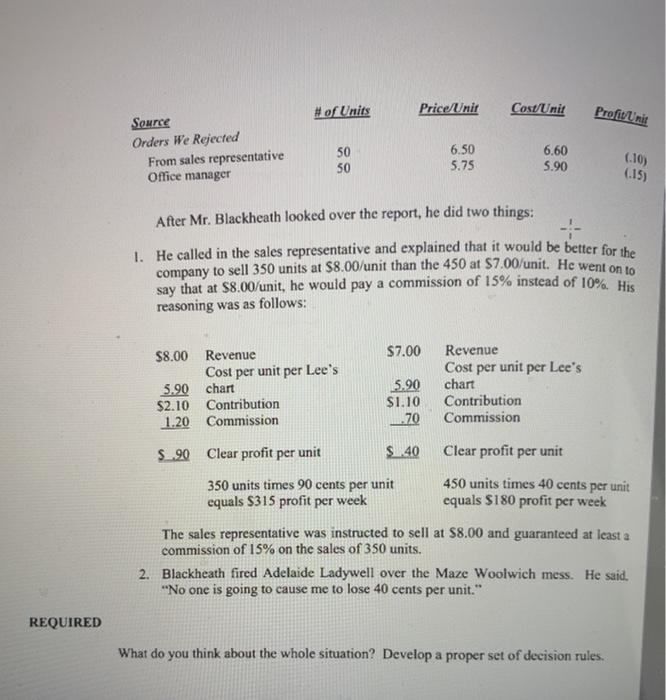
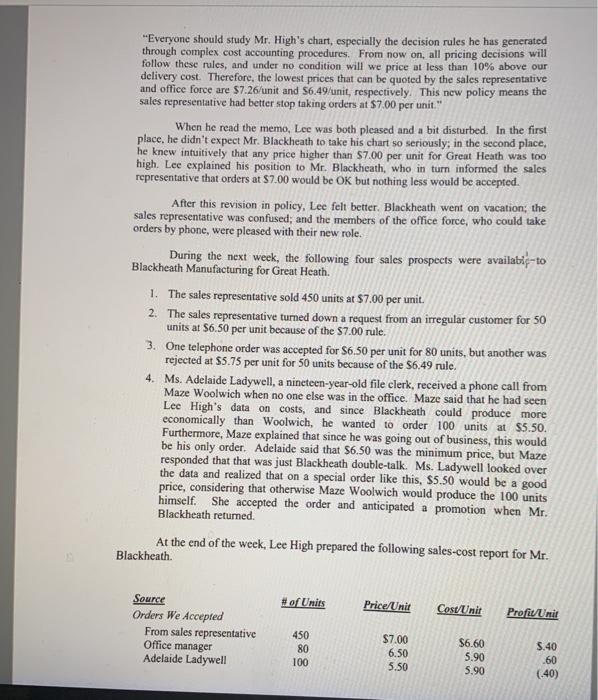

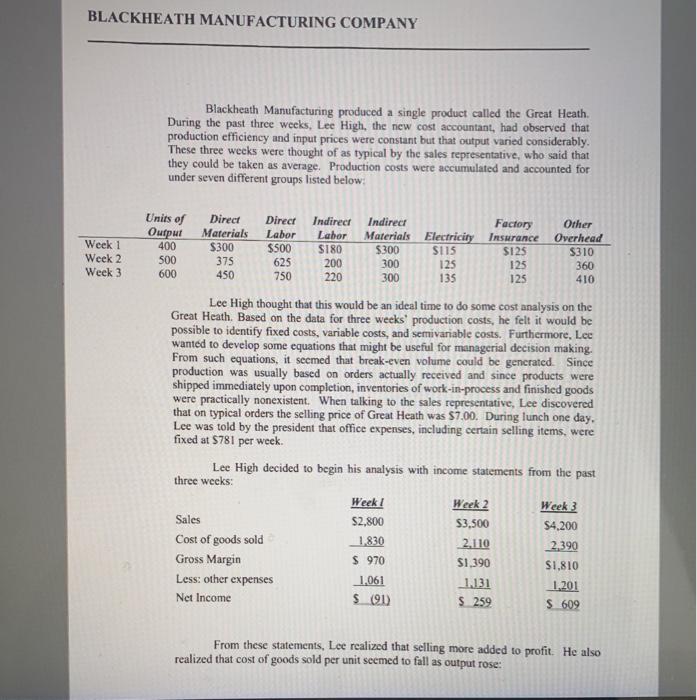
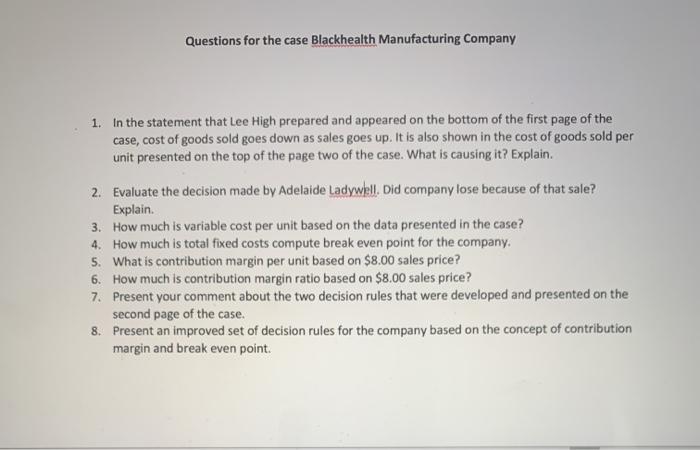
# of Units Price Unit Cost/Unit Profid Unit Source Orders We Rejected From sales representative Office manager 50 50 6.50 5.75 6.60 5.90 (.10) (.15) After Mr. Blackheath looked over the report, he did two things: 1. He called in the sales representative and explained that it would be better for the company to sell 350 units at $8.00/unit than the 450 at $7.00/unit. He went on to say that at $8.00/unit , he would pay a commission of 15% instead of 10%. His reasoning was as follows: $7.00 $8.00 Revenue Cost per unit per Lee's 5.90 chart $2.10 Contribution 1.20 Commission 5.90 $1.10 .70 Revenue Cost per unit per Lee's chart Contribution Commission $ 90 Clear profit per unit S40 Clear profit per unit 350 units times 90 cents per unit equals $315 profit per week 450 units times 40 cents per unit equals $180 profit per week The sales representative was instructed to sell at $8.00 and guaranteed at least a commission of 15% on the sales of 350 units. 2. Blackheath fired Adelaide Ladywell over the Maze Woolwich mess. He said. "No one is going to cause me to lose 40 cents per unit." REQUIRED What do you think about the whole situation? Develop a proper set of decision rules. "Everyone should study Mr. High's chart, especially the decision rules he has generated through complex cost accounting procedures. From now on, all pricing decisions will follow these rules, and under no condition will we price at less than 10% above our delivery cost. Therefore, the lowest prices that can be quoted by the sales representative and office force are $7.26/unit and $6.49/unit, respectively. This new policy means the sales representative had better stop taking orders at $7.00 per unit." When he read the memo, Lee was both pleased and a bit disturbed. In the first place, he didn't expect Mr. Blackheath to take his chart so seriously, in the second place, he knew intuitively that any price higher than $7.00 per unit for Great Heath was too high. Lee explained his position to Mr. Blackheath, who in turn informed the sales representative that orders at $7.00 would be OK but nothing less would be accepted. After this revision in policy, Lee felt better. Blackheath went on vacation, the sales representative was confused; and the members of the office force, who could take orders by phone, were pleased with their new role. During the next week, the following four sales prospects were availabi - to Blackheath Manufacturing for Great Heath. 1. The sales representative sold 450 units at $7.00 per unit. 2. The sales representative turned down a request from an irregular customer for 50 units at $6.50 per unit because of the $7.00 rule. 3. One telephone order was accepted for $6.50 per unit for 80 units, but another was rejected at $5.75 per unit for 50 units because of the $6.49 rule. 4. Ms. Adelaide Ladywell , a nineteen-year-old file clerk, received a phone call from Maze Woolwich when no one else was in the office. Maze said that he had seen Lee High's data on costs, and since Blackheath could produce more economically than Woolwich, he wanted to order 100 units at $5.50. Furthermore, Maze explained that since he was going out of business, this would be his only order. Adelaide said that $6.50 was the minimum price, but Maze responded that that was just Blackheath double-talk. Ms. Ladywell looked over the data and realized that on a special order like this, $5.50 would be a good price, considering that otherwise Maze Woolwich would produce the 100 units himself. She accepted the order and anticipated a promotion when Mr. Blackheath returned. At the end of the week, Lee High prepared the following sales-cost report for Mr. Blackheath #of Units Price Unit Cost/Unit Profit Unit Source Orders We Accepted From sales representative Office manager Adelaide Ladywell 450 80 100 $7.00 6.50 5.50 $6.60 5.90 5.90 $.40 .60 (.40) When sales were 400, then cost of goods sold per unit was 54.58. When sales were 500, then cost of goods sold per unit was 54.22. When sales were 600, then cost of goods sold per unit was $3.98. He reasoned that there was Lee wasn't sure why cost of goods sold per unit should fall, because, after all, the efficiency and input prices had remained the same. Since the three weeks for which Lee had data were thought to be typical, he decided that something odd about the data and decided it would be good to work with some average some "standardized cost information based on sales of 500 units per week would be very helpful. He derived the following chart: Useful Data on Great Heath Average variable cost per unit produced Average fixed cost per unit produced $2.80 1.42 54.22 Average fixed administrative and selling cost per unit Commission per unit sold 1.56 1.70 $6.48 Added amount for rounding error and some "funny" results in data $6,60 The following should be kept in mind when selling Great Heath: 1. It costs us $6.60 to deliver a unit of Great Heath, so we make only 40 cents per unit at $7.00 selling price. 2. Decision rule #1 (for sales representative on the road): Never sell Great Heath for less than $6.60 plus a profit margin because at $6.60 we just break even. 3. Decision rule #2 (for direct office sales on which no commission is paid): Never sell Great Heath for less than $5.90 plus a profit margin because at $5.90 we just break even. Lee was very pleased with his chart, particularly the part about different decision rules. When the chart was finished, Lee passed it on to Mr. Charlton Blackheath, who was the owner, president and chief decision maker at Blackheath Manufacturing, Charlton, who was skeptical of "scientific analysis," studied Lee High's chart and underlying data. That night Charlton said to his lawyer, with whom he was having dinner, "I finally have found the kind of practical fast-track analyst I need. This kid, Lee High, has just developed a set of decision rules that will solve all my pricing and profit problems." The next day Charlton Blackheath sent a memo to the sales representative and others who were involved in pricing Great Heath. Among other things the memo stated BLACKHEATH MANUFACTURING COMPANY Blackheath Manufacturing produced a single product called the Great Heath. During the past three weeks, Lee High, the new cost accountant, had observed that production efficiency and input prices were constant but that output varied considerably. These three weeks were thought of as typical by the sales representative, who said that they could be taken as average. Production costs were accumulated and accounted for under seven different groups listed below: Units of Output 400 Week 1 Week 2 Week 3 Direct Materials $300 375 450 Direct Labor $500 625 750 Indirect Labor $180 200 220 Indirect Factory Materials Electricity Insurance $300 S115 $125 300 125 125 300 135 125 Other Overhead $310 360 410 500 600 Lee High thought that this would be an ideal time to do some cost analysis on the Great Heath. Based on the data for three weeks' production costs, he felt it would be possible to identify fixed costs, variable costs, and semivariable costs. Furthermore, Lee wanted to develop some equations that might be useful for managerial decision making. From such equations, it seemed that break-even volume could be generated. Since production was usually based on orders actually received and since products were shipped immediately upon completion, inventories of work-in-process and finished goods were practically nonexistent. When talking to the sales representative, Lee discovered that on typical orders the selling price of Great Heath was $7.00. During lunch one day. Lee was told by the president that office expenses, including certain selling items, were fixed at $781 per week Lee High decided to begin his analysis with income statements from the past three weeks Week 1 Week 2 Week 3 Sales $2.800 $3,500 $4,200 Cost of goods sold 1,830 2.110 2.390 Gross Margin $ 970 S1.390 S1,810 Less: other expenses 1.131 1.201 Net Income $ 120 $ 259 $ 609 1,061 From these statements, Lee realized that selling more added to profit. He also realized that cost of goods sold per unit seemed to fall as output rose: Questions for the case Blackhealth Manufacturing Company 1. In the statement that Lee High prepared and appeared on the bottom of the first page of the case, cost of goods sold goes down as sales goes up. It is also shown in the cost of goods sold per unit presented on the top of the page two of the case. What is causing it? Explain. 2. Evaluate the decision made by Adelaide Ladywhell. Did company lose because of that sale? Explain. 3. How much is variable cost per unit based on the data presented in the case? 4. How much is total fixed costs compute break even point for the company. 5. What is contribution margin per unit based on $8.00 sales price? 6. How much is contribution margin ratio based on $8.00 sales price? 7. Present your comment about the two decision rules that were developed and presented on the second page of the case. 8. Present an improved set of decision rules for the company based on the concept of contribution margin and break even point 




Step by Step Solution
There are 3 Steps involved in it
Step: 1

Get Instant Access to Expert-Tailored Solutions
See step-by-step solutions with expert insights and AI powered tools for academic success
Step: 2

Step: 3

Ace Your Homework with AI
Get the answers you need in no time with our AI-driven, step-by-step assistance
Get Started


